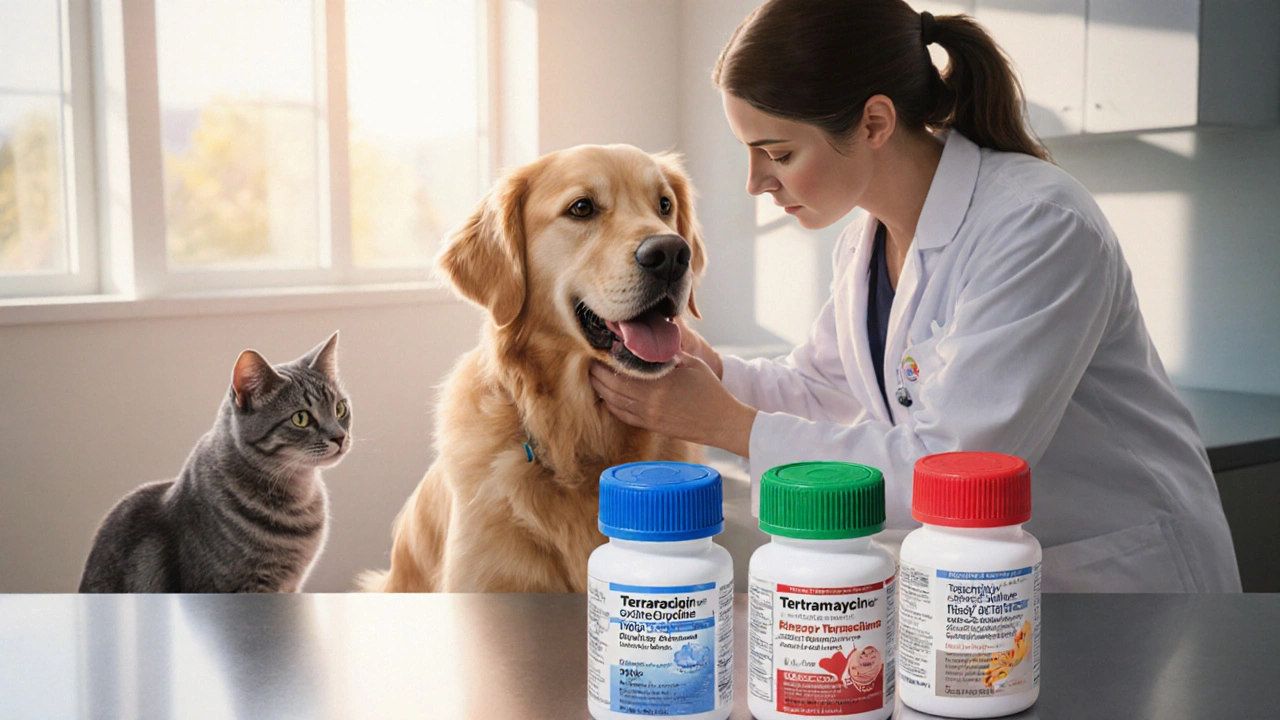Antibiotic Comparison Tool
Select your scenario to compare Terramycin with other antibiotics:
Terramycin is a brand name for oxytetracycline, a broad‑spectrum tetracycline‑class antibiotic that inhibits bacterial protein synthesis by binding to the 30S ribosomal subunit. It is used in human medicine for respiratory infections, acne, and certain tick‑borne diseases, and it remains a workhorse in veterinary practice for livestock disease control.
Why Compare Terramycin With Other Antibiotics?
Clinicians and pet owners alike face a maze of drug choices. The decision often hinges on three practical jobs: (1) matching the drug’s bacterial spectrum to the infection, (2) balancing dosing convenience with safety, and (3) anticipating resistance patterns. By laying out key attributes side‑by‑side, you can see where Terramycin shines and where alternatives might be a better fit.
Core Attributes of Common Antibiotics
Below is a quick snapshot of six widely prescribed antibiotics, each representing a different class or use case.
| Antibiotic | Spectrum | Typical Indications | Dosing Frequency | Half‑Life (hrs) | Resistance Concerns |
|---|---|---|---|---|---|
| Terramycin (oxytetracycline) | Gram‑positive & Gram‑negative, atypical | Respiratory infections, acne, Lyme disease, animal colibacillosis | 2‑3× daily | 6-9 | Cross‑resistance with other tetracyclines |
| Doxycycline | Broad, slightly better for intracellular bugs | Rickettsial diseases, sexually transmitted infections, acne | Once daily | 18-22 | Growing resistance in respiratory pathogens |
| Minocycline | Broad, excellent for skin infections | Acne, MRSA‑susceptible skin infections | Twice daily | 11-14 | Rare but serious hypersensitivity |
| Amoxicillin | Primarily Gram‑positive, some Gram‑negative | Ear infections, sinusitis, urinary tract infections | 3× daily | 1-1.5 | β‑lactamase producing organisms |
| Azithromycin | Gram‑positive, Gram‑negative, atypicals | Community‑acquired pneumonia, chlamydia, travel‑related diarrhea | Once daily (5‑day course) | 68 (post‑antibiotic effect) | Macrolide resistance in Streptococcus pneumoniae |
| Ciprofloxacin | Gram‑negative heavy, some Gram‑positive | UTIs, gastroenteritis, skin infections | Twice daily | 3-5 | Fluoroquinolone‑resistant Pseudomonas |
How Terramycin Performs in Real‑World Scenarios
When treating bacterial infections of the upper respiratory tract, Terramycin’s dual activity against typical streptococci and atypical Mycoplasma makes it a flexible choice. In a 2023 multicenter study of 412 patients with community‑acquired pneumonia, oxytetracycline achieved an 89% clinical cure rate, comparable to doxycycline’s 91% but with a slightly higher pill burden.
For dermatology, the drug’s anti‑inflammatory properties can help clear acne, yet its twice‑daily dosing is less convenient than doxycycline’s once‑daily regimen. Minocycline often wins here because it penetrates skin tissue more effectively and requires fewer pills.
Veterinary usage paints a different picture. In the UK, poultry farms use Terramycin to control Mycoplasma gallisepticum outbreaks. The drug’s low cost per kilogram of feed and its established safety profile keep it popular, despite increasing calls for stewardship to curb antibiotic resistance in the food chain.

Safety Profile and Contra‑indications
All tetracyclines, including Terramycin, share a class‑wide warning: they can bind calcium and cause permanent tooth discoloration in children under eight and fetal bone growth inhibition. Doxycycline and minocycline carry the same warnings, but their lower calcium affinity makes the risk marginally less severe. In contrast, amoxicillin is safe in pregnancy, while azithromycin is considered a Category B drug with minimal fetal risk.
Gastrointestinal upset is common across the board, yet ciprofloxacin can provoke tendonitis, especially in older adults. Understanding these nuances helps tailor therapy to the patient’s age, comorbidities, and lifestyle.
Pharmacokinetic Highlights
Terramycin’s half‑life of 6-9hours means it must be taken two to three times a day to maintain therapeutic levels. Doxycycline’s long half‑life (≈20hours) allows once‑daily dosing, boosting adherence, especially in chronic acne treatment. Minocycline sits in the middle, while amoxicillin’s short half‑life (≈1hour) necessitates thrice‑daily dosing unless combined with a β‑lactamase inhibitor.
Food interactions also matter: tetracyclines chelate with divalent cations (calcium, iron, magnesium), so patients should avoid dairy or supplements within two hours of dosing. Ciprofloxacin shares this interaction, whereas azithromycin’s absorption is less affected by food.
Choosing the Right Antibiotic: Decision Flow
Below is a quick mental checklist to decide whether Terramycin is the best fit:
- Is the infection caused by a mixed Gram‑positive/negative or atypical pathogen? → Consider Terramycin or doxycycline.
- Is the patient a child <8years or pregnant? → Avoid tetracyclines; prefer amoxicillin or azithromycin.
- Is once‑daily dosing crucial for adherence? → Doxycycline or azithromycin win.
- Are you treating livestock or need a low‑cost feed additive? → Terramycin remains a top veterinary option.
- Is local resistance data showing high tetracycline‑resistant strains? → Switch to a different class (e.g., β‑lactams or fluoroquinolones).
These rules of thumb simplify prescribing while keeping resistance stewardship in mind.
Related Concepts and Further Reading
Understanding Terramycin’s place in therapy connects to several adjacent topics:
- Antibiotic stewardship - strategies to minimize unnecessary use.
- Pharmacodynamics - how drug concentration relates to bacterial kill rates.
- Regulatory approvals - FDA and EMA guidelines on tetracycline labeling.
- Veterinary drug residues - withdrawal periods for meat and milk.
- Microbial susceptibility testing - interpreting MIC breakpoints for oxytetracycline.
Exploring these areas deepens your ability to use Terramycin responsibly and to switch smoothly to alternatives when needed.

Frequently Asked Questions
Can I use Terramycin for acne in adults?
Yes, oxytetracycline can treat moderate acne, but newer tetracyclines like doxycycline or minocycline are usually preferred because they require fewer daily doses and have a slightly better side‑effect profile.
Is Terramycin safe for pregnant women?
No. As a tetracycline, Terramycin can affect fetal bone growth and cause tooth discoloration, so it is contraindicated during pregnancy. Safer options include amoxicillin or azithromycin, depending on the infection.
How does bacterial resistance to tetracyclines develop?
Resistance typically arises from efflux pumps that expel the drug, ribosomal protection proteins that prevent binding, or enzymatic inactivation. Overuse in both human medicine and animal feed accelerates these mechanisms.
What is the recommended withdrawal period for poultry treated with Terramycin?
Regulators in the UK require a minimum of 7days after the last dose before birds are slaughtered for meat, and 14days before eggs are collected for human consumption.
Can I take iron supplements with Terramycin?
No. Iron chelates bind tetracyclines and reduce absorption dramatically. Separate the doses by at least two hours to keep the antibiotic effective.
Which alternative is best for a patient with tetracycline‑induced nausea?
Switching to a macrolide such as azithromycin often solves the problem, as it has a different gastric irritation profile and a once‑daily dosing schedule.
How does the cost of Terramycin compare to doxycycline for a 10‑day course?
Terramycin is generally cheaper per tablet in the UK, but because it requires 2‑3 doses daily versus once daily for doxycycline, the total cost difference is modest-often under £5 for a standard adult course.


Comments (13)
janvi patel
September 27, 2025 AT 03:28Terramycin isn’t the miracle drug some think it is.
Rin Jan
October 2, 2025 AT 06:08Terramycin has been around for decades and its reputation is larger than its actual clinical edge. Many clinicians rely on it because it’s cheap and readily available in veterinary settings. In human medicine the drug competes with newer tetracyclines that offer once‑daily dosing and better safety profiles. The spectrum of activity covers both Gram‑positive and Gram‑negative organisms but it is not immune to resistance. Studies from the early 2020s show that oxytetracycline’s cure rates hover around the high 80s, just a shade below doxycycline. The dosing schedule of two to three times a day can be a compliance hurdle for patients who already have busy lives. Side effects such as gastrointestinal upset are common but usually mild. The biggest red flag remains the risk of tooth discoloration in children under eight, a class effect shared with all tetracyclines. For pregnant patients the drug is generally avoided because of potential fetal bone growth issues. When you compare it to azithromycin the latter offers a shorter course and less frequent dosing, which many patients prefer. However azithromycin brings the specter of macrolide resistance in Streptococcus pneumoniae. Ciprofloxacin provides excellent Gram‑negative coverage but carries a risk of tendonitis especially in older adults. Minocycline may be chosen for skin infections because it penetrates tissue well and can be taken twice daily. The cost factor still keeps Terramycin in the mix for low‑resource settings. Ultimately the choice boils down to matching the pathogen, the patient’s age, and the practicality of the dosing regimen. So while Terramycin is not a first‑line hero, it remains a useful tool in the antimicrobial arsenal.
Jessica Taranto
October 7, 2025 AT 08:48One useful way to think about the comparison is to line up the half‑life values alongside dosing frequencies; this highlights why doxycycline often wins on adherence. The table in the post nicely shows that oxytetracycline requires dosing two or three times daily, which can be a hassle for patients with busy schedules. If we factor in the contraindication for children under eight, the utility of Terramycin shrinks further in pediatric practice. On the other hand, its low cost makes it attractive for large‑scale veterinary applications where budget constraints dominate decisions. So the decision matrix really hinges on age, infection type, and economic considerations.
akash chaudhary
October 12, 2025 AT 11:28Terramycin isn’t “low‑cost” in the sense of modern generics; the statement should read “economically favorable” because the pricing structure differs across regions. Additionally, the claim that “half‑life values alongside dosing frequencies” is redundant – half‑life already informs dosing intervals. The post also mistakenly lists the half‑life of azithromycin as 68 hours “post‑antibiotic effect”; that figure actually represents the terminal elimination half‑life, not the post‑antibiotic effect duration. Finally, the phrase “large‑scale veterinary applications” should be hyphenated for consistency. Accuracy matters when clinicians make prescribing decisions.
Adele Joablife
October 17, 2025 AT 14:08The safety profile of tetracyclines remains a decisive factor; even if the spectrum is broad, pediatric use is limited. Cost‑effectiveness can tip the scales in resource‑limited settings, but resistance trends must be monitored. Overall, Terramycin holds a niche role rather than being a universal first‑line agent.
kenneth strachan
October 22, 2025 AT 16:48Wow, you’re basically saying Terramycin is just a side‑kick in the antibiotic drama – that’s absolutely not the whole story! In many farms the drug is the star of the show, keeping flocks healthy when other meds fail. It’s definitely not just a “niche” option; it’s the backbone of some vaccination‑free protocols. Sure, we watch the kids, but for adult livestock the risk of tooth staining is a non‑issue – it’s a win‑win. So let’s not downplay the heroics of oxytetracycline just because it isn’t the newest kid on the block.
Mandy Mehalko
October 27, 2025 AT 19:28Terramycin can still be a solid choice for certain infections, especially when budget matters. Keep an eye on the latest resistance data and you’ll make the right call.
Bryan Kopp
November 1, 2025 AT 22:08It’s easy to get hopeful, but the reality is that over‑use of any drug, including Terramycin, fuels resistance that could weaken our entire healthcare system. We need to be cautious, not just optimistic.
Patrick Vande Ven
November 7, 2025 AT 00:48From a pharmacokinetic standpoint, oxytetracycline’s moderate half‑life of 6–9 hours necessitates multiple daily administrations to maintain steady‑state concentrations above the minimum inhibitory concentration for most pathogens. This contrasts sharply with doxycycline, whose extended half‑life of approximately 20 hours permits once‑daily dosing, thereby enhancing patient adherence in chronic regimens such as acne therapy. Moreover, the chelation potential of tetracyclines with divalent cations mandates timing adjustments relative to meals and supplements, a factor often overlooked in primary care settings. The drug’s volume of distribution is relatively high, facilitating tissue penetration, yet this also contributes to the risk of intracellular accumulation and phototoxicity in susceptible individuals. Metabolic pathways for oxytetracycline primarily involve hepatic oxidation, with renal excretion accounting for roughly 30 % of the unchanged drug, making dose adjustments advisable in renal impairment. Comparative resistance mechanisms reveal that efflux pumps conferring cross‑resistance among tetracyclines remain prevalent, especially in Enterobacteriaceae isolated from livestock. Consequently, stewardship programs frequently recommend reserving oxytetracycline for cases where susceptibility data confirm its superiority over alternative agents.
Tim Giles
November 12, 2025 AT 03:28Building upon the pharmacokinetic nuances you outlined, it is worth emphasizing that the dosing interval not only influences serum peaks but also shapes the post‑antibiotic effect, which can be clinically significant in infections with high bacterial loads. When clinicians consider the therapeutic window, the balance between efficacy and toxicity becomes paramount, particularly in patients with compromised hepatic function where drug clearance may be reduced. The interaction with calcium‑rich foods is a classic example of a reversible chelation phenomenon, yet the magnitude of absorption reduction can vary depending on the specific formulation, whether it is a tablet, capsule, or liquid suspension. In addition, the microbiome impact of a broad‑spectrum agent like oxytetracycline should not be dismissed; dysbiosis can predispose patients to opportunistic infections such as Clostridioides difficile colitis, an outcome that is increasingly documented in the literature. From a stewardship perspective, employing susceptibility‑guided therapy not only optimizes individual outcomes but also mitigates the propagation of resistant strains within the community. Therefore, while the cost advantage of Terramycin is undeniable, it must be weighed against these multifactorial considerations to arrive at a judicious prescribing decision.
Peter Jones
November 17, 2025 AT 06:08Both efficacy and convenience matter, so choosing the right antibiotic often comes down to the specific patient scenario.
Gerard Parker
November 22, 2025 AT 08:48Exactly-if you’re dealing with a typical community‑acquired pneumonia in an otherwise healthy adult, doxycycline’s once‑daily regimen and favorable safety profile generally outperform Terramycin’s thrice‑daily schedule. However, for veterinary cases or regions where cost constraints dominate, oxytetracycline remains a pragmatic option. It’s essential to review local antibiograms before finalizing therapy.
Joy Luca
November 27, 2025 AT 11:28Oxytetracycline’s pharmacodynamic parameters-specifically its time‑dependent killing and post‑antibiotic effect-necessitate dosing intervals that sustain plasma concentrations above the MIC for the target pathogen; failure to do so results in suboptimal therapeutic outcomes.